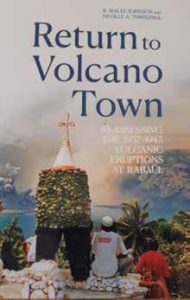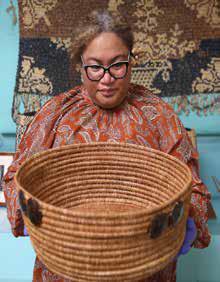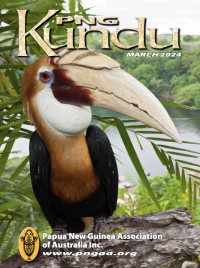BOOKS & ART REVIEWS
R Wally Johnson & Neville A Threlfall
Return to Volcano Town—Reassessing the 1937–1943 Eruptions at Rabaul
 This is an expanded, more detailed version of the book published by the same authors in 1985—Volcano Town: The 1937–43 Eruptions. That book they considered to be a public awareness document for local consumption, given the apprehension then felt about a recurrence of the earlier disasters.
This is an expanded, more detailed version of the book published by the same authors in 1985—Volcano Town: The 1937–43 Eruptions. That book they considered to be a public awareness document for local consumption, given the apprehension then felt about a recurrence of the earlier disasters.
This new book includes description of the eruptions and earthquake activity from 1994 to 2014, but also records the prolific disaster management and geoscientific investigations that have continued in the Blanche Bay area since the re-establishment of the Rabaul Vulcanological Observatory in 1950.
Another motivation for the new book was to deal in greater detail with the eruptions of the twin volcanoes, Vulcan and Tavurvur, in 1878 and to compare those events with the eruptions of 1937–43.
The book begins with a discussion of the establishment of Rabaul as the new colonial German capital after its earlier siting at Herbertshöhe (Kokopo). The Tolai people, plantation operators and missionaries knew about the volcanic nature of the area but the safety of Simpson Harbour as a port was a compelling reason for re-location to Rabaul.
There was continuing earthquake activity in and around Rabaul after the administration of the former German Territory became Australia’s responsibility in 1914. Although recommendations for a geophysical laboratory and a volcano observatory were made in a report by Evan Stanley, the Government Geologist of the Territory of Papua in a report in 1923, no official seismological studies were done until after the 1937 eruptions.
About one quarter of the book’s content deals with the 1937 eruption and the response of the community—800 Caucasians, 1,000 Asians and about 8,000 New Guineans—the Tolai people and indentured labourers.
Although gurias had been a regular feature of life in Rabaul since European settlement began, the devastation caused by the eruption, which began on 29 May, a Saturday afternoon, was unexpected and no plans for dealing with such an emergency existed.
Later chapters describe the scientific investigations which followed immediately after the eruptions ceased and continue to this day. Medical and vulcanological experts prepared reports for the Administration who determined that refugees who had fled to Kokopo should return to Rabaul and that the town should continue as capital of the Territory.
The vulcanologist’s report recommended the establishment of a vulcanology laboratory and this was effected in 1939.
By mid-June 1941 Tavurvur erupted again, providing some relief from the boredom of garrison duties for the young soldiers of Lark Force. These eruptions continued until 7 October. Tavurvur was active again in late 1943 by which time Japan had developed Rabaul as a major base and had established its own seismic testing facility. The book’s authors concluded that these eruptions were the last in the 1937–43 series.
After the war Rabaul was rebuilt despite doubts about its continuing exposure to the likelihood of volcanic eruption. Part of that rebuilding was the re-establishment of the Vulcanological Laboratory and the collection of data. Collectively, this data indicated the likelihood of further serious eruptions from Vulcan and Tavurvur.
This came to pass in 1994 when, once again, Rabaul was severely damaged by twin eruptions of its two volcanoes and the fall-out of ash and, finally, abandoned.
The authors’ analysis of information about recorded eruptions from 1878 to 2014 and the frequency of near simultaneous eruption of volcanoes on either side of Rabaul Harbour suggest the existence of a common pool of magma under the harbour. Perhaps even more serious eruptions will occur in the future.
Unlike the earlier version of this book, this edition includes references to the publications cited and a list of the authors’ research collections now in the National Library of Australia and accessible to the public. Future editions would be improved by the addition of an index.
The authors, both of whom spent many years in Rabaul, have written a masterful account of its volcanoes and their impact on the land and its people.
ISBN (print): 9781760466039
ISBN (online): 9781760466046
Published by ANU Press, Canberra ACT 2600 (2023)
407 pages, pictures, maps
Available from ANU Press, $A69.95
Step Inside Australia’s Latest Haven for Pacific Culture
The new Wansolmoana: One Salt Ocean permanent Pasifika Gallery at the Australian Museum opened in October 2023.
 Wansolmoana was curated by the Australian Museum’s Pasifika team and cultural knowledge holders in Australia and the Pacific. This exhibition celebrates the complex, varied and dynamic cultures and languages of today’s Pasifika peoples.
Wansolmoana was curated by the Australian Museum’s Pasifika team and cultural knowledge holders in Australia and the Pacific. This exhibition celebrates the complex, varied and dynamic cultures and languages of today’s Pasifika peoples.
Breathtaking objects from the world-renowned Pacific cultural collections of the Australian Museum are accompanied by contemporary artworks and newly acquired pieces.
Delve into the ties Pasifika peoples have with the past, each other and the environment; a space dedicated to our young Pacific people, a reminder of who you are, where you come from and what you are made of.
Wansolmoana—meaning One Salt Ocean—reflects the cultural significance of the immense body of water that connects the islands and people across the Pacific region.
It blends the wisdom of ancestors with the voices of the present to ensure a vibrant legacy for future generations through stories and objects from across the region.




